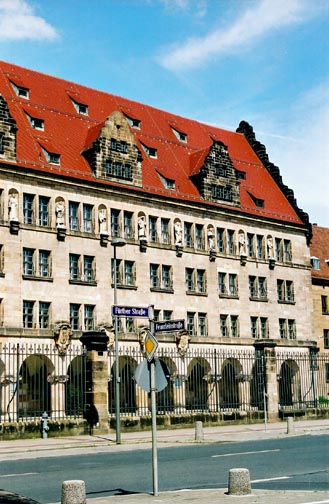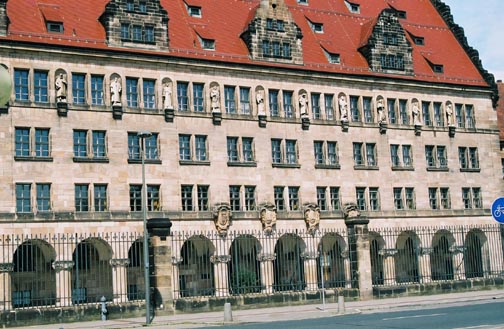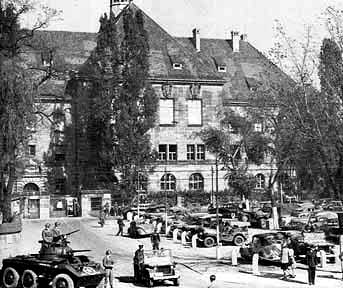Justice at Nuremberg

Before 1945, the city of Nürnberg
(Nuremberg) was most famous for producing a type of gingerbread
called Nürnberger Lebkuchen; now the city is known the world
over as the location of the proceedings before the International
Military Tribunal where German war criminals were put on trial
in the aftermath of World War II.

To Americans, the name Nuremberg is synonymous
with Justice, just as the name Munich is synonymous with Appeasement.
The Palace of Justice (Justizgebäude) at Fürtherstrasse
22, where the trial took place, is still being used as a courthouse;
the building is shown in the photographs on this page.

Trials are still being conducted in room
#600, the very room where the leaders of the Third Reich sat
as they listened to testimony about their Crimes against Peace,
War Crimes, and Crimes against Humanity over half a century ago.
The Justizgebäude, where the defeated Germans faced the
judgment of the victorious Allies, is on the opposite side of
the city, and a world away, from the Zeppelin Field where Hitler
addressed the cheering crowds and the German Army once paraded
in all its glory.
The first trial, in 1945, at the Palace of Justice was the Trial of the Major War Criminals before the International Military Tribunal, consisting of prosecutors and judges from the United States, Great Britain, France and the Soviet Union. A second set of trials, known as the Nuremberg Military Tribunals, were conducted by the United States. The most famous of these trials were the Doctors' Trial and the Judges' Trial.
The Trial of the Major War Criminals
began on November 20, 1945; British judge Sir Goeffrey Lawrence
called the court to order, saying that "This trial, which
is now about to begin, is unique in the annals of jurisprudence."
The trial ended nine months later on October 1, 1946.
The trial was unprecedented because the
prosecutors who conducted the trial and the judges who made up
the jury were both from the victorious Allies only. The International
Tribunal and the charges against the Germans had been created
under the terms of an agreement among the Allies, known as the
London Charter, signed on August 8, 1945.
At the main trial, there were 100,000
documents accepted into evidence and the transcript of the trial
filled 42 volumes with more than 5 million words. According to
the US Holocaust Memorial Museum, Allied prosecutors submitted
some 3,000 tons of records at the Nuremberg IMT. The defense
was not allowed access to any documents except the ones that
were actually used by the prosecution.
One of the most important witnesses at
the International Military Tribunal was Rudolf Höss, also
known as Rudolf Hoess, who was a defense witness for Ernst Kaltenbrunner,
one of the men on trial. During his cross examination by the
prosecution, an affidavit which he had signed on May 14, 1946
was introduced. This was his confession, sworn under oath, in which he
admitted that 2 million Jews had been put to death by gassing
and half a million more by other means while he was the Commandant
of Auschwitz. This did not include the Hungarian Jews who were
gassed while Hoess was not the Commandant.
There were 403 open sessions conducted
by the IMT, and 113 witnesses were called to the stand including
33 for the prosecution and 80 for the defense. Many prosecution
witnesses gave testimony in an affidavit and did not take the
stand, so the defense had no opportunity to cross examine them
under oath. Even when Ernst Kaltenbrunner demanded that a prosecution
witness take the stand so that he could confront him, the request
was denied.
The complete transcript of the main Nuremberg
trial, with the 216 days of testimony against the 22 defendants,
was published in book form and it is also available online on the Internet.
Below is an old photograph of the east
wing of the Palace of Justice where the trial was held. The courtroom
in Room 600 is in the center of the east wing on the top floor.
In the photo, the room can be identified by the curtains covering
two of the windows.

Room 600 is in the
center of the east wing
The entire trial was captured on film and shown to the world on TV. Newsreel films showed the city of Nürnberg as a pile of rubble, which had not yet been cleared when the trial started; the bodies of 20,000 German civilians were still buried under the destroyed buildings as the German war criminals were brought into the courtroom of the Palace of Justice. The Palace of Justice had suffered some damage in the Allied bombing of Nürnberg, but it had been restored by the forced labor of the conquered Germans before the trial began.
It was at the Nuremberg trials that the whole world learned for the first time about the German atrocities, including all the gory details of the medical experiments on prisoners, the shrunken heads, the soap made from human fat, the leather goods made from the skin of concentration camp prisoners, and the gas chambers which accounted for the majority of the deaths at Auschwitz and Majdanek, where the Russians testified that not less than 4 million people had died in the Auschwitz complex and another 1.5 million had died at the Majdanek camp. Today, the figures given for these camps is 1.1 million deaths at Auschwitz and 78,000 at Majdanek, including 59,000 Jews.
The horror films of the Allied liberation
of the Nazi concentration camps at Bergen-Belsen, Buchenwald
and Dachau were shown at the trial, to the defendants and to
the public. An American-made documentary film, which showed all the graphic details
of the gas pipes and control wheels which regulated the flow
of poison gas through the shower heads of the Dachau gas chamber,
was shown in the courtroom on November 29, 1945.
The German military and economic leaders
were visibly stunned by this proof of a gas chamber at Dachau, and claimed that they
were seeing and hearing about this unprecedented atrocity for
the first time. The American public was horrified that such a
thing could have taken place in the civilized world.
Today, tourists are not allowed to see
the gas pipes and control wheels that were shown in the courtroom
at Nuremberg. Instead, they are shown bins on the outside wall of the gas chamber which were allegedly used to put the poison gas pellets into the room.
The Nuremberg IMT was more than just
a trial. It was a graphic presentation to the entire world that
the Allies had fought "the Good War" against the evil
Nazis.
The following quote is from the web site
of the United States Holocaust Memorial Museum:
The goals of the International Military
Tribunal (IMT) transcended verdict and punishment. The creators
of the court were deliberately assembling a public record of
the horrific crimes committed by Germans during World War II,
including those of the Holocaust. American chief prosecutor Robert
Jackson worried that "unless record was made future generations
would not believe how horrible the truth was."
In order to avoid any accusation of
exclusive reliance on personal testimony, which later generations
might perceive to be biased, prosecutors decided to base their
case primarily on thousands of documents written by the Germans
themselves. These masses of documents were translated into the
court's four official languages, analyzed for their significance,
and reproduced for distribution to defense attorneys and other
trial participants. The prosecution presented other evidence
through artifacts, diagrams, and photographs taken by Nazi photographers
in concentration camps.
Nineteen investigative teams scoured
German records, interviewed witnesses, and visited the sites
of atrocities to build the case.
Some of the incriminating documents had
been found by the 90th Infantry Division of the US Army in April
1945, hidden in a salt mine near the little town of Merkers,
Germany, according to the USHMM.
The charges at the Nuremberg main trial
were based on the rules contained in Control Council Law No.
10 which stated the four categories of crimes, as follows:
CONTROL COUNCIL
Law No. 10
[...]
Article II
1. Each of the following acts is recognized
as a crime:
(a) Crimes against Peace. Initiation
of invasions of other countries and
wars of aggression in violation of international laws and treaties,
including but not limited to planning, preparation, initiation
or waging
a war of aggression, or a war of violation of international treaties,
agreements or assurances, or participation in a common plan or
conspiracy for the accomplishment of any of the foregoing.
(b) War Crimes. Atrocities or offenses
against persons or property
constituting violations of the laws or customs of war, including
but not
limited to, murder, ill treatment or deportation to slave labour
or for
any other purpose, of civilian population from occupied territory,
murder or ill treatment of prisoners of war or persons on the
seas,
killing of hostages, plunder of public or private property, wanton
destruction of cities, towns or villages, or devastation not
justified
by military necessity.
(a) Crimes against Humanity. Atrocities
and offenses, including but not
limited to murder, extermination, enslavement, deportation,
imprisonment, torture, rape, or other inhumane acts committed
against
any civilian population, or persecutions on political, racial
or
religious grounds whether or not in violation of the domestic
laws of
the country where perpetrated.
(d) Membership in categories of a
criminal group or organization
declared criminal by the International Military Tribunal.
Control Council Law No. 10 included all
war crimes committed by the Nazi regime against any and all nations
and individuals between January 30, 1933, when Hitler was sworn
in as Chancellor of Germany, and July 1, 1945.
Beginning in November 1945, a few days
before the start of the IMT main trial, there were American Military Tribunal proceedings conducted
at Dachau which included only crimes committed by the Germans
against Allied nationals in concentration camps in Germany and
Austria between January 1, 1942 and the liberation of each camp.
This was roughly the period of time during which America was
at war with Germany.
For the most part, the International
Military Tribunal charged the defendants, not with individual
responsibility for specific crimes, but with a "Common Plan"
to commit crimes.
According to the book "Justice at
Nuremberg" by Robert E. Conot, the idea for the Common Plan
charges against the Germans came from Lieutenant Colonel Murray
C. Bernays, a Lithuanian Jew who had emigrated to American in
1900 at the age of six. Before the trial, according to Conot's
book, Churchill and Roosevelt's advisor Henry Morgenthau, Jr.
had advocated that "the principal Nazi leaders should be
charged with their crimes, then summarily shot." Bernays
argued for a trial as "the educational and therapeutic opportunity
of our generation." Regarding the Nazi crimes, Bernays wrote
"The crimes and atrocities were not single or unconnected,
but the inevitable outcome of the basic criminal conspiracy of
the Nazi party."
There was nothing in international law
which allowed a charge of participating in a "Common Plan."
The German war criminals were specifically
charged with violating the Hague convention of 1907 by invading
and attacking countries without a formal declaration of war and
with the violation of the Kellogg-Briand Pact of 1928 which called
for Renunciation of War as an Instrument of National Policy.
Under each of the three counts in the indictment, a detailed
list of all the German crimes was entered by each of the four
Allied countries: Great Britain, the United States of America,
France and the Soviet Union.
Any atrocities committed by the Allies were not considered war crimes. After the war, France passed a law that no French citizen could be charged with a war crime.
The Soviet Union accused the German military
and specifically Hermann Goering, head of the German Air Force,
of committing the Katyn Forrest Massacre of 11,000 Polish army
officers in September 1941. The Germans had brought in American
POWs as observers when the bodies were dug up. An American soldier
testified for the defense regarding the Katyn Forrest Massacre;
in 1989 the world learned that his testimony was correct when
the Soviet Union admitted that it was really the Russians who
had murdered a total of 15,000 Polish army officers before June
1941, and had falsely accused the Germans.
Hermann Goering, recognized by the court
as the No. 2 man in Germany, was the most important witness for
the defense. He defended the overthrow of the Weimar Republic
in Germany by the Nazis, and claimed that the concentration camps
were necessary and legal.
German citizens had rights similar to
the rights of Americans under our Constitution, but the German
Constitution included Article 48, the emergency clause, which
allowed for civil rights to be suspended. Hitler had used Article
48 to suspend Germany's equivalent of our Fourth Amendment right
after the Reichstag fire on the night of February 27, 1933.
Starting in April 1942, America set up internment camps for Japanese-American citizens which violated their Fourth Amendment rights, but Germany's concentration camps were technically legal under the German Constitution.
On the third day of his cross examination of Hermann Goering, Jackson questioned him about the treatment of the Jews in Nazi Germany, including the anti-Jewish Nuremberg Laws on Citizenship which Goering had signed in September 1935.
Then Jackson confronted Goering with the most incriminating piece of evidence in the entire trial: a letter dated July 31, 1941, in which Goering had ordered Reinhard Heydrich, the chief of the Reich Security Main Office (RSHA), to prepare a plan for the "Final solution of the Jewish question." Goering testified that the German term "Die Endlösung" in the letter should have been translated as the "total solution," and that it referred only to "the emigration of the Jews," not the extermination of Jews.
The Protocols of the Wannsee Conference, at which the "Final
Solution" was planned, were not found until 1947, so this
important document was not included in the mountain of evidence
introduced at the International Military Tribunal at which the
German war criminals were tried for Crimes against Humanity.
The phrase “Endlösung der Judenfrage” was not originated by Hermann Goering.
Long before the Wannsee Conference, the phrase “Endlösung der Judenfrage” appeared in the 1897 manifesto of the Zionist “National Jewish Association – Cologne”:
“ Experience has shown that civic emancipation has fallen short of securing the social and cultural future of the Jewish people. The Final Solution of the Jewish Question lies therefore in the establishment of the Jewish State.”
Theodor Herzl the "Father of Zionism'" used the term "the final solution of the Jewish Question" in an 1899 letter to the Russian Czar:
"I supplemented this endeavor in my covering letter to the Czar:
"Sire: It is to the graciousness of His Royal Highness the Grand Duke of Baden, who has Grand Duke of Baden, who has consented to become the exalted sponsor of my humble request for an audience with Your Imperial Majesty, that I owe my permission to submit the Zionist plan for the final solution of the Jewish Question." Source: The complete diaries of Theodor Herzl, Volume 3
The Nuremberg trial had far-reaching
consequences - for America and the world. In 1948 President Harry
Truman desegregated the American armed forces, and in 1954 after
the U.S. Supreme Court ruled that school segregation was unconstitutional,
Justice Robert Jackson who participated in the decision said
that the Nuremberg experience and the "awful consequences
of racial prejudice revealed by ... the Nazi regime" had
influenced his decision.
According to Conot's book, before the
Nuremberg International Military Tribunal proceedings, there
was no international criminal code; the barbaric practices of
the Nazis became war crimes under international law, only after
the IMT proceedings, when the United Nations passed the Genocide
Convention and a Declaration of Human Rights.
After World War II, the rules of warfare
changed: reprisals can no longer be taken against hostages or
Prisoners of War; forced labor is now outlawed; captured partisans
are given equal status with regular POWs. The Germans had been
convicted of all these crimes before they were crimes. The verdicts
at the Nuremberg IMT established international law and the actions
of the Germans in World War II are now war crimes.
Regulations of all the major World War
II armies now state that orders which would constitute the commission
of a crime need not be obeyed. All the crimes that were revealed
at the Nuremberg trial have now been incorporated into international
law and the defense used at the Nuremberg trial by the German
generals and admirals that they were just obeying orders is no
longer valid.
This page was last updated on November 12, 2012
|